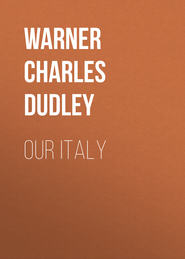По всем вопросам обращайтесь на: info@litportal.ru
(©) 2003-2024.
✖
In The Levant
Настройки чтения
Размер шрифта
Высота строк
Поля
“Then perhaps you can tell us, if this tomb belonged to Joseph of Arimathea and this to Nicodemus, whose is this third one?”
“O yes, that other,” replied the guide, with only a moment’s paralysis of his invention, “that is the tomb of Arimathea himself.”
One afternoon at four, service was going on in the Greek chapel, which shone with silver and blazed with tapers, and was crowded with pilgrims, principally Russians of both sexes, many of whom had made a painful pilgrimage of more than two thousand miles on foot merely to prostrate themselves in this revered place. A Russian bishop and a priest, in the resplendent robes of their office, were intoning the service responsively. In the very centre of this chapel is a round hole covered with a grating, and tapers are generally burning about it. All the pilgrims kneeled there, and kissed the grating and adored the hole. I had the curiosity to push my way through the throng in order to see the object of devotion, but I could discover nothing. It is, however, an important spot: it is the centre of the earth; though why Christians should worship the centre of the earth I do not know. The Armenians have in their chapel also a spot that they say is the real centre; that makes three that we know of, for everybody understands that there is one in the Kaaba at Mecca.
We sat down upon a stone bench near the entrance of the chapel, where we could observe the passing streams of people, and were greatly diverted by a blithe and comical beggar who had stationed himself on the pavement there to intercept the Greek charity of the worshippers when they passed into the rotunda. He was a diminutive man with distorted limbs; he wore a peaked red cap, and dragged himself over the pavement, or rather skipped and flopped about on it like a devil-fish on land. Never was seen in a beggar such vivacity and imperturbable good-humor, with so much deviltry in his dancing eyes.
As we appeared to him to occupy a neutral position as to him and his victims, he soon took us into his confidence and let us see his mode of operations. He said (to our guide) that he was a Greek from Damascus,—O yes, a Christian, a pilgrim, who always came down here at this season, which was his harvest-time. He hoped (with a wicked wink) that his devotion would be rewarded.
It was very entertaining to see him watch the people coming out, and select his victims, whom he would indicate to us by a motion of his head as he hopped towards them. He appeared to rely more upon the poor and simple than upon the rich, and he was more successful with the former. But he rarely, such was his insight, made a mistake. Whoever gave him anything he thanked with the utmost empressement of manner; then he crossed himself, and turned around and winked at us, his confederates. When an elegantly dressed lady dropped the smallest of copper coins into his cap, he let us know his opinion of her by a significant gesture and a shrug of his shoulders. But no matter from whom he received it, whenever he added a penny to his store the rascal chirped and laughed and caressed himself. He was in the way of being trodden under foot by the crowd; but his agility was extraordinary, and I should not have been surprised at any moment if he had vaulted over the heads of the throng and disappeared. If he failed to attract the attention of an eligible pilgrim, he did not hesitate to give the skirt of his elect a jerk, for which rudeness he would at once apologize with an indescribable grimace and a joke.
When the crowd had passed, he slid himself into a corner, by a motion such as that with which a fish suddenly darts to one side, and set himself to empty his pocket into his cap and count his plunder, tossing the pieces into the air and catching them with a chuckle, crossing himself and hugging himself by turns. He had four francs and a half. When he had finished counting his money he put it in a bag, and for a moment his face assumed a grave and business-like expression. We thought he would depart without demanding anything of us. But we were mistaken; he had something in view that he no doubt felt would insure him a liberal backsheesh. Wriggling near to us, he set his face into an expression of demure humility, held out his cap, and said, in English, each word falling from his lips as distinctly and unnaturally as if he had been a wooden articulating machine,—
“Come unto me all ye that labor and are heavy laden, and I will give you rest.”
The rascal’s impiety lessened the charity which our intimacy with him had intended, but he appeared entirely content, chirped, saluted with gravity, and, with a flop, was gone from our sight.
At the moment, a procession of Franciscan monks swept by, chanting in rich bass voices, and followed, as usual, by Latin pilgrims, making the daily round of the holy places; after they had disappeared we could still hear their voices and catch now and again the glimmer of their tapers in the vast dark spaces.
Opposite the place where we were sitting is the Chapel of the Apparition, a room not much more than twenty feet square; it is the Latin chapel, and besides its contiguity to the sepulchre has some specialties of its own. The chapel is probably eight hundred years old. In the centre of the pavement is the spot upon which our Lord stood when he appeared to the Virgin after the resurrection; near it a slab marks the place where the three crosses were laid after they were dug up by Helena, and where the one on which our Lord was crucified was identified by the miracle that it worked in healing a sick man. South of the altar is a niche in the wall, now covered over, but a round hole is left in the covering. I saw pilgrims thrust a long stick into this hole, withdraw it, and kiss the end. The stick had touched a fragment of the porphyry column to which the Saviour was bound when he was scourged.
In the semicircle at the east end of the nave are several interesting places: the prison where Christ was confined before his execution, a chapel dedicated to the centurion who pierced the side of our Lord, and the spot on which the vestments were divided. From thence we descend, by a long flight of steps partly hewn in the rock, to a rude, crypt-like chapel, in the heavy early Byzantine style, a damp, cheerless place, called the Chapel of Helena. At the east end of it another flight of steps leads down into what was formerly a cistern, but is now called the Chapel of the Invention of the Cross. Here the cross was found, and at one side of the steps stands the marble chair in which the mother of Constantine sat while she superintended the digging. Nothing is wanting that the most credulous pilgrim could wish to see; that is, nothing is wanting in spots where things were. This chapel belongs to the Latins; that of Helena to the Greeks; the Abyssinian convent is above both of them.
On the south side of the church, near the entrance, is a dark room called the Chapel of Adam, in which there is never more light than a feeble taper can give. I groped my way into it often, in the hope of finding something; perhaps it is purposely involved in an obscurity typical of the origin of mankind. There is a tradition that Adam was buried on Golgotha, but the only tomb in this chapel is that of Melchizedek! The chapel formerly contained that of Godfrey de Bouillon, elected the first king of Jerusalem in 1099, and of Baldwin, his brother. We were shown the two-handed sword of Godfrey, with which he clove a Saracen lengthwise into two equal parts, a genuine relic of a heroic and barbarous age. At the end of this chapel a glimmering light lets us see through a grating a crack in the rock made by the earthquake at the crucifixion.
The gloom of this mysterious chapel, which is haunted by the spectre of that dim shadow of unreality, Melchizedek, prepared us to ascend to Golgotha, above it. The chapels of Golgotha are supported partly upon a rock which rises fifteen feet above the pavement of the church. The first is that of the Elevation of the Cross, and belongs to the Greeks. Under the altar at the east end is a hole in the marble which is over the hole in the rock in which the cross stood; on either side of it are the holes of the crosses of the two thieves. The altar is rich with silver and gold and jewels. The chamber, when we entered it, was blazing with light, and Latin monks were performing their adorations, with chanting and swinging of incense, before the altar. A Greek priest stood at one side, watching them, and there was plain contempt in his face. The Greek priests are not wanting in fanaticism, but they never seem to me to possess the faith of the Latin branch of the Catholic church. When the Latins had gone, the Greek took us behind the altar, and showed us another earthquake-rent in the rock.
Adjoining this chapel is the Latin Chapel of the Crucifixion, marking the spot where Christ was nailed to the cross; from that we looked through a window into an exterior room dedicated to the Sorrowing Virgin, where she stood and beheld the crucifixion. Both these latter rooms do not rest upon the rock, but upon artificial vaults, and of course can mark the spots commemorated by them only in space.
Perhaps this sensation of being in the air, and of having no standing-place even for tradition, added something to the strange feeling that took possession of me; a mingled feeling that was no more terror than is the apprehension that one experiences at a theatre from the manufactured thunder behind the scenes. I suppose it arose from cross currents meeting in the mind, the thought of the awful significance of the events here represented and the sight of this theatrical representation. The dreadful name, Golgotha, the gloom of this part of the building,—a sort of mount of darkness, with its rent rock and preternatural shadow,—the blazing contrast of the chapel where the cross stood with the dark passages about it, the chanting and flashing lights of pilgrims ever coming and going, the neighborhood of the sepulchre itself, were well calculated to awaken an imagination the least sensitive. And, so susceptible is the mind to the influence of that mental electricity—if there is no better name for it—which proceeds from a mass of minds having one thought (and is sometimes called public opinion), be it true or false, that whatever one may believe about the real location of the Holy Sepulchre, he cannot witness, unmoved, the vast throng of pilgrims to these shrines, representing as they do every section of the civilized and of the uncivilized world into which a belief in the cross has penetrated. The undoubted sincerity of the majority of the pilgrims who worship here makes us for the time forget the hundred inventions which so often allure and as often misdirect that worship.
The Church of the Holy Sepulchre offers at all times a great spectacle, and one always novel, in the striking ceremonies and the people who assist at them. One of the most extraordinary, that of the Holy Fire, at the Greek Easter, which is three weeks later than the Roman, and which has been so often described, we did not see. I am not sure that we saw even all the thirty-seven holy places and objects in the church. It may not be unprofitable to set down those I can recall. They are,—
The Stone of Unction.
The spot where the Virgin Mary stood when the body of our Lord was anointed.
The Holy Sepulchre.
The stone on which the angel sat.
The tombs of Joseph of Arimathea and Nicodemus.
The well of Helena.
The stone marking the spot where Christ in the form of a gardener appeared to Mary Magdalene.
The spot where Mary Magdalene stood.
The spot where our Lord appeared to the Virgin after his resurrection.
The place where the true cross, discovered by Helena, was laid, and identified by a miracle.
The fragment of the Column of Flagellation.
The prison of our Lord.
The “Bonds of Christ,” a stone with two holes in it.
The place where the title on the cross was preserved.
The place of the division of the vestments.
The centre of the earth (Greek).
The centre of the earth (Armenian).
The altar of the centurion who pierced the body of Christ.
The altar of the penitent thief.
The Chapel of Helena.
The chair in which Helena sat when the cross was found.
The spot where the cross was found.
The Chapel of the Mocking, with a fragment of the column upon which Jesus sat when they crowned him with thorns.
The Chapel of the Elevation of the Cross.
The spot where the cross stood.
The spots where the crosses of the thieves stood.
The rent rock near the cross.
The spot where Christ was nailed to the cross.
The spot where the Virgin stood during the crucifixion.
The Chapel of Adam.
The tomb of Melchizedek.
The rent rock in the Chapel of Adam.
The spots where the tombs of Godfrey and Baldwin stood.








